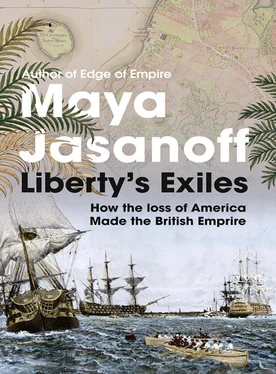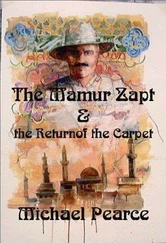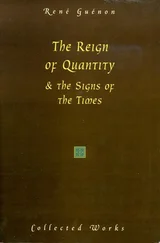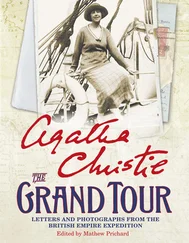But what if you hadn’t wanted the British to leave? Mixed in among the happy New York crowd that day were other, less cheerful faces. 7For loyalists—colonists who had sided with Britain during the war—the departure of the British troops spelled worry, not jubilation. During the war, tens of thousands of loyalists had moved for safety into New York and other British-held cities. The British withdrawal raised urgent questions about their future. What kind of treatment could they expect in the new United States? Would they be jailed? Would they be attacked? Would they retain their property, or hold on to their jobs? Confronting real doubts about their lives, liberty, and potential happiness in the United States, sixty thousand loyalists decided to follow the British and take their chances elsewhere in the British Empire. They took fifteen thousand black slaves with them, bringing the total exodus to seventy-five thousand people—or about one in forty members of the American population. 8
They traveled to Canada, they sailed for Britain, they journeyed to the Bahamas and the West Indies; some would venture still farther afield, to Africa and India. But wherever they went, this voyage into exile was a trip into the unknown. In America the refugees left behind friends and relatives, careers and land, houses and native streets—the entire milieu in which they had built their lives. For them, America seemed less “an Assylum to the persecuted” than a potential persecutor. It was the British Empire that would be their asylum, offering land, emergency relief, and financial incentives to help them start over. Evacuation Day did not mark an end for the loyalist refugees. It was a fresh beginning—and it carried them into a dynamic if uncertain new world.
JACOB BAILEY, for one, could give a vivid account of what led him to flee revolutionary America. Massachusetts born and bred, Bailey had since 1760 been an Anglican missionary in the frontier district of Pownalborough, Maine. While he ministered in what was then remote wilderness, in Boston his Harvard classmate John Adams voiced the colonies’ grievances against Britain, and became a forceful advocate for independence. But Bailey had sworn what he regarded as a sacred oath to the king, the head of his church, and to renounce that allegiance appeared to him to be an act of both treason and sacrilege. Bailey struggled to maintain his loyalty in the face of mounting pressure to join the rebellion. When he refused to honor a special day of thanksgiving declared by the provincial congress, Pownalborough patriots threatened to put up a liberty pole in front of the church and to whip him there if he failed to bless it. 9Another frightening omen came when he found seven of his sheep slaughtered, and a “fine heifer” shot dead in his pasture. 10By 1778, the clergyman had been “twice assaulted by a furious Mob—four times haulled before an unfeeling committee. . . . Three times have I been driven from my family....Two attempts have been made to shoot me.” He roved the countryside to elude arrest, while his young wife and their children tried to get by with “nothing to eat for several days together.” To Bailey the patriots were persecutors, plain and simple, a “set of surly & savage beings who have power in their hands and murder in their hearts, who thirst, and pant, and roar for the blood of those who have any connection with, or affection for Great Britain.” 11
Bailey certainly had a flair for sensational language. His melodramatic prose, however, spoke to genuine fear for his family’s safety. Still unwilling to renounce the king—yet equally unwilling to risk imprisonment for refusing to do so—he saw only one more option before him, unappealing though it was. Before dawn one June day in 1779, the Baileys grimly “began to prepare for our expulsion.” They dressed in a motley assortment of salvaged clothes, gathered up their bedding and “the shattered remains of our fortune,” and made their way to a boat that would carry them to Nova Scotia, the nearest British sanctuary. In spite of all they had suffered, Jacob and Sally Bailey could not hold back their “bitter emotions of grief ” on leaving their native country. Neither could they contain their relief, two weeks later, when they sailed into Halifax harbor and saw “the Britanic colours flying.” 12Bailey gave thanks to God “for safely conducting me and my family to this retreat of freedom and security from the rage of tyranny and the cruelty of opposition.” Now they were in the British Empire; now they were secure. But the Baileys had landed “in a strange country, destitute of money, clothing, dwelling or furniture,” and their future was in the hands of chance. 13
This book follows refugees like Jacob Bailey out of revolutionary America to provide the first global history of the loyalist diaspora. Though historians have probed the experiences of loyalists within the colonies (and especially the ideology of articulate figures like Bailey), the international displacement of loyalists during and after the war has never been described in full. 14Who were these refugees and why did they leave? The answers came in as many forms as the people themselves. Loyalists are often stereotyped as members of a small conservative elite: rich, educated, Anglican, and with strong ties to Britain—qualities captured by the pejorative label “tory,” the nickname for the British Conservative Party. 15In fact, historians estimate that between a fifth and a third of American colonists remained loyal to the king. 16Loyalism cut right across the social, geographical, racial, and ethnic spectrum of early America—making loyalists every bit as “American” as their patriot fellow subjects. Loyalists included recent immigrants and Mayflower descendants alike. They could be royal officials as well as bakers, carpenters, tailors, and printers. There were Anglican ministers as well as Methodists and Quakers; cosmopolitan Bostonians and backcountry farmers in the Carolinas.
Crucially, not all loyalists were white. For the half million black slaves in the thirteen colonies, the revolution presented a striking opportunity when British officers offered freedom to slaves who agreed to fight. Twenty thousand slaves seized this promise, making the revolution the occasion for the largest emancipation of North American slaves until the U.S. Civil War. For native American Indians, too, the revolution posed a pressing choice. Encroached on by generations of land-hungry colonists, several Indian nations—notably the Mohawks in the north and the Creeks in the south—opted to ally themselves with the British Empire. The experiences of loyal whites, blacks, and Indians have generally been segregated into distinct historical narratives, and of course there were important differences among them. 17But loyalists of all backgrounds confronted a common dilemma with Britain’s defeat—to stay or go—and all numbered among the revolution’s refugees. Their stories were analogous and entangled in significant ways, which is why they will be presented together here.
Perhaps the most surprising truth about loyalist refugees was how varied a role ideology might play in their decision-making. Though they shared an allegiance to the king and a commitment to empire, their precise beliefs otherwise ranged widely. Some, like Bailey, expressed sophisticated intellectual reasons for their position. For others, loyalism stemmed from a personal commitment to the existing order of things, a sense that it was better to stick with the devil you knew. Also widespread was a pragmatic opinion that the colonies were economically and strategically better off as part of the British Empire. 18The extent and depth of loyalism points to a fundamental feature of this conflict that the term “revolution” belies. This was quite simply a civil war—and routinely described as such by contemporaries on both sides of the Atlantic. 19Polarizing communities, destroying friendships, dividing families—most famously Benjamin Franklin, the founding father, from his only son William, a loyalist—this was the longest war Americans fought before Vietnam, and the bloodiest until the Civil War of 1861–65. Recovering the contingency, coercion, and sheer violence of the American Revolution explains why so many loyalists chose to depart—driven, like Jacob Bailey, by fear of harassment as much as by commitment to principle. By the same token, self-interest could be as powerful a motivator as core beliefs, as the cases of runaway slaves and Britain’s Indian allies perhaps make most clear.
Читать дальше











